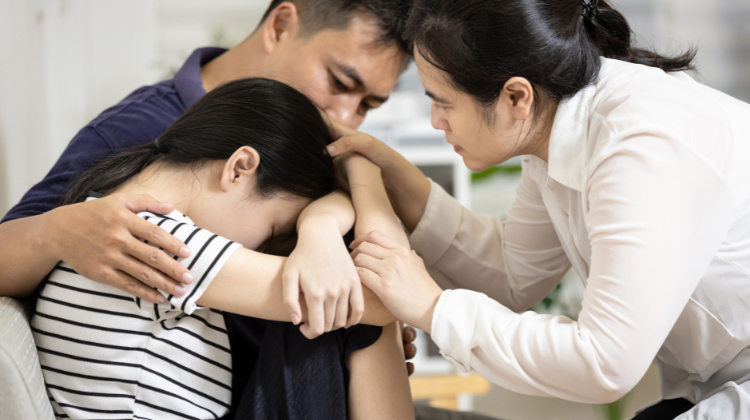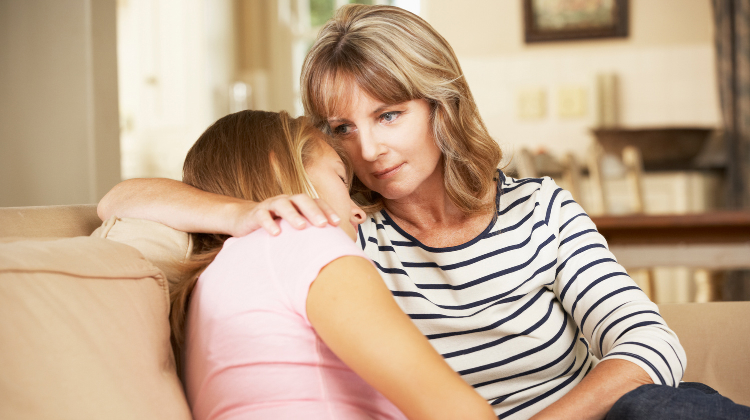 Expert's opinion
Expert's opinion
Expert's opinion
The article is a subjective view on this topic written by writers specializing in medical writing.
It may reflect on a personal journey surrounding struggles with an illness or medical condition, involve product comparisons, diet considerations, or other health-related opinions.
Although the view is entirely that of the writer, it is based on academic experiences and scientific research they have conducted; it is fact-checked by a team of degreed medical experts, and validated by sources attached to the article.
The numbers in parenthesis (1,2,3) will take you to clickable links to related scientific papers.
How to Help with Teenage Depression 2024: Guide & Advice for Parents

For parents, one of the worst things in life is seeing their child struggle. When they’re struggling with schoolwork or sports, that’s one thing; when they’re going through depression, it’s something else entirely. Depression isn’t something you can help them practice.
Parents everywhere are wondering how to help with teenage depression and whether there’s anything they can do at all. But there are ways you can help, and you can learn to recognize the signs and the causes.
How to Help a Teenager with Depression
While every teenager has different symptoms and needs, there are a few things that you can do that are likely to help overall. Try your best to stay consistent with these methods and pay careful attention to how your teenager responds.
- Listen
- Keep them busy
- Keep them healthy
- Stay alert
Symptoms of Teenage Depression
The following are a few of the most common symptoms expressed by teenagers suffering from depression. If you see your teenager expressing even just one of these symptoms, it may be time to take action.
Loss of Interest
This is likely to be one of the largest and most noticeable of your teen’s symptoms. Things they used to love and be passionate about might fall to the wayside. One of the ways depression is commonly described is that, although you’re not sad all the time, nothing makes you happy, either.
Moving on from interests[1] you used to have is a normal part of the teen years, so the signs may be hard to separate from ordinary teenage habits. But if your teen never seems to take an interest in anything, even things like skateboarding that you might find silly, then you need to be alert.
Isolation
Teenagers who develop depression tend to retreat and isolate themselves from everyone else. A depressed teen has difficulty reaching out to friends and family – it just starts to feel like a chore. So they don’t.
In a cruel twist of fate, this resulting isolation only makes their depression worse, making them feel alone and like nobody cares about them, in a vicious cycle. Again, though, don’t mistake this for just ordinary teenage life.
Teenagers are known to retreat from their families and not enjoy time together as much. It’s hard to tell normal teenage isolation apart from depressed teenage isolation, at least where your family is concerned. A good warning sign to look for is whether or not they are also isolated from their friends and peers.
Change of Habits
Eating and sleeping habits change a lot during depression. A teenager typically sleeps more and eats more because their body requires it; a depressed teenager, however, eats more and sleeps more because it’s something they can do when they feel like nothing is enjoyable.
Spending a lot of time sleeping allows you to avoid your waking life if you feel like it’s miserable, and eating helps you get a little bit of pleasure out of your body’s automatic response to food when nothing else gives you any.
It’s hard to know what kind of eating and sleeping is normal for a teenager and what’s concerning unless you’ve had several. Try talking to other mothers you know through school groups or something similar, and check your experience against theirs.
Fatigue and Memory Loss
It’s a well-known fact that teenagers are always tired, especially when you need them to do their chores. But depression is different. Depression makes every part of your life feel exhausting, and even things that should be enjoyable feel like work.
Spending time with friends and family isn’t fun anymore; it’s tiring because you must keep pretending to be happy.
All of this can contribute to serious fatigue in depressed teens. Fatigue and memory loss can also be signs of other, more physical illnesses, so talk to your teen’s doctor as well.
Note that not all of these symptoms will apply to every case, and there are others that are also signed, like substance abuse, failing school grades, and restlessness. So do your research[2] and be sure to pay attention to everything, even things that don’t seem to matter.
Causes of Depression in Teens
Teenagers experience a lot of change during this period of their lives, and that alone can cause a lot of stress. Here are some of the most common causes of depression in teens.
Hormones
During the teenage years, emotions run wild. This is especially noticeable in adolescent girls, but it happens to all teenagers.
Most depression has been linked to irregular brain chemistry[3], most notably serotonin imbalance, and teenagers’ changing brains make them particularly susceptible to such problems. That’s part of why teen depression is so common.
Trauma
If your teenager has experienced trauma, that’s extremely important to be aware of. Things like rape or loss are obvious sources, but anything sufficiently distressing to a child can be a trauma for them.
By the time they’re a teenager, they might not even realize they had lingering trauma from a car accident when they were five years old.
Living through a natural disaster like a hurricane or an earthquake is another source of trauma that could manifest in depression during the teenage years. The most common is still probably the loss of friends or family members, so give special attention to events like that.
Isolation (Possibly Related to COVID)
Depression and depressed teens spiked dramatically in 2020 and 2021. This is not a coincidence. The isolation of the pandemic destroyed people’s mental health. Mental illness skyrocketed, and suicide soared. It’s not hard to understand that people need to be around other people. It’s how we evolved.
Being isolated from everyone except immediate family had horrible consequences for many people.
Plus, you couldn’t even see a therapist in person and get that personal contact! Online therapy is great, but it’s even better if you can actually see a physical person in front of you. In-person body language[4] is just as important as facial expression in communication.
Besides all of that, everyone spending their time in a single place contributed to feelings of being trapped and helpless.
Nobody felt like they had any control over their lives, least of all teenagers-the people who are desperately trying to take more control from their parents. So it’s no wonder depression has been at an all-time high[5].
Bullying
Bullying is a common cause of adolescent depression. To a teenager, whatever is happening in their life feels huge, overwhelming, and absolute. Unfortunately, a few mean kids make it seem like absolutely everyone hates them, especially if they have no friends their own age to be there for them, to be on their side.
Maybe you’re thinking, “But I’m there for them! I’m supportive!” But that doesn’t help your teen. To them, family members don’t count, and adults might as well be on another planet.
It’s people their age who are everything. If the people around them at school don’t think they’re worthwhile, then they must not be worthwhile. This leads to depression and even suicide very quickly.
Effective Ways to Help with Teenage Depression
Figuring out how to help your teen with depression can be one of the most trivial tasks. Take a look at the following ways many parents have found helpful when aiding their teens.
Listen

This might sound silly–or maybe obvious–but a big problem throughout the teen years is feeling like nobody listens to you. Make time to talk to your teenager, face to face, without any distractions. If your family isn’t in the habit of eating meals together[6], try to start doing that – it’s a great place for communication to happen.
A therapist can also be important. Most of the benefit of a therapist is just listening. Again, it sounds silly, but that sometimes takes a lot of training!
Learning to listen without arguing, suggesting, or giving advice is a challenge, so consider a specialist in adolescent psychiatry if you feel like your conversations go nowhere.
Keep Them Busy

As mentioned above, part of the danger of teenage depression is that it causes them to be isolated from other people and from the activities they enjoy, which only makes their depression worse.
Try to encourage them to get outdoors[7], see their friends, and spend time with their family. Take a family hiking trip. Go see a movie together. If they have any hobbies, ask to help in a relevant area; if you have any hobbies, ask them for help.
For example, if your teen is interested in running or hiking, ask them to walk the dog. If they love nature watching, ask them to identify whether a plant in your garden is a weed.
Even if you don’t actually need the help, come up with something. It makes them feel useful and encourages them to pursue hobbies from which depression might be keeping them.
Keep Them Healthy

Depression is usually linked to biology. Unhealthy living can cause or worsen depression. In fact, exercise, good sleep hygiene[8], and healthy eating are all parts of common teenage depression treatment!
Good ways to encourage a healthy lifestyle include limiting screen time and unhealthy snacks, providing good meals, and keeping teenagers active.
If they don’t have any physical activity, try to interest them in some; joining a sports team or a dance club, for example. We, humans, are social creatures, and socializing[9] is normalizing when depression threatens wellness with isolation.
Teenagers should ideally get an hour of physical activity every day. Also, try to encourage healthy sleeping habits, as teens need more sleep than adults, between nine to ten hours a night.
Stay Alert

Suicide is an unfortunately common result of teenage depression[10]. If your child has depression, keep an eye out for signs they might be considering suicide.
Learn the phone number of the national suicide prevention lifeline, and try to help your teen find resources designed for them.
And keep an eye out for warning signs: referring to death, giving away belongings, looking for weapons. Contact a mental health professional immediately if you see any of these signs.
The Bottom Line
The best way you can help your teen is to keep them invested in their life, which depression is trying to isolate them from. Encourage them to be healthy and active, to spend time with friends and family, and engage in their favorite activities.
Results may be slow or invisible, but your support is one of the most important things they can have during this time – that and, if necessary, professional help to reduce and eliminate possible risks of suicide.
Most importantly, clinical depression[11] should be treated: the most common cause of suicide is untreated or inadequately treated depression.
+ 11 sources
Health Canal avoids using tertiary references. We have strict sourcing guidelines and rely on peer-reviewed studies, academic researches from medical associations and institutions. To ensure the accuracy of articles in Health Canal, you can read more about the editorial process here
- Australia, H. (2019). Losing interest. [online] www.healthdirect.gov.au. Available at: https://www.healthdirect.gov.au/losing-interest.
- Mayo Clinic. (2022). Teen depression – Symptoms and causes. [online] Available at: https://www.mayoclinic.org/diseases-conditions/teen-depression/symptoms-causes/syc-20350985
- Arango, V., Underwood, M.D. and Mann, J.John. (2002). Chapter 35 Serotonin brain circuits involved in major depression and suicide. Progress in Brain Research, [online] pp.443–453. doi:10.1016/s0079-6123(02)36037-0.
- Melinda (2018). Nonverbal Communication and Body Language. [online] HelpGuide.org. Available at: https://www.helpguide.org/articles/relationships-communication/nonverbal-communication.htm
- World (2022). COVID-19 pandemic triggers 25% increase in prevalence of anxiety and depression worldwide. [online] Who.int. Available at: https://www.who.int/news/item/02-03-2022-covid-19-pandemic-triggers-25-increase-in-prevalence-of-anxiety-and-depression-worldwide
- 7 benefits of eating together as a family (2014). 7 benefits of eating together as a family. [online] Swedish.org. Available at: https://blog.swedish.org/swedish-blog/7-benefits-of-eating-together-as-a-family
- US Forest Service. (2021). The wellness benefits of the great outdoors | US Forest Service. [online] Available at: https://www.fs.usda.gov/features/wellness-benefits-great-outdoors
- Sleep Foundation. (2009). 5 Simple Tips For Getting a Good Night’s Sleep. [online] Available at: https://www.sleepfoundation.org/sleep-hygiene
- Morawski, J. (2014). Socialization. Encyclopedia of Critical Psychology, [online] pp.1820–1826. doi:10.1007/978-1-4614-5583-7_295.
- National Institute of Mental Health (NIMH). (2022). Teen Depression: More Than Just Moodiness. [online] Available at: https://www.nimh.nih.gov/health/publications/teen-depression
- National Institute of Mental Health (NIMH). (2022). Depression. [online] Available at: https://www.nimh.nih.gov/health/topics/depression



